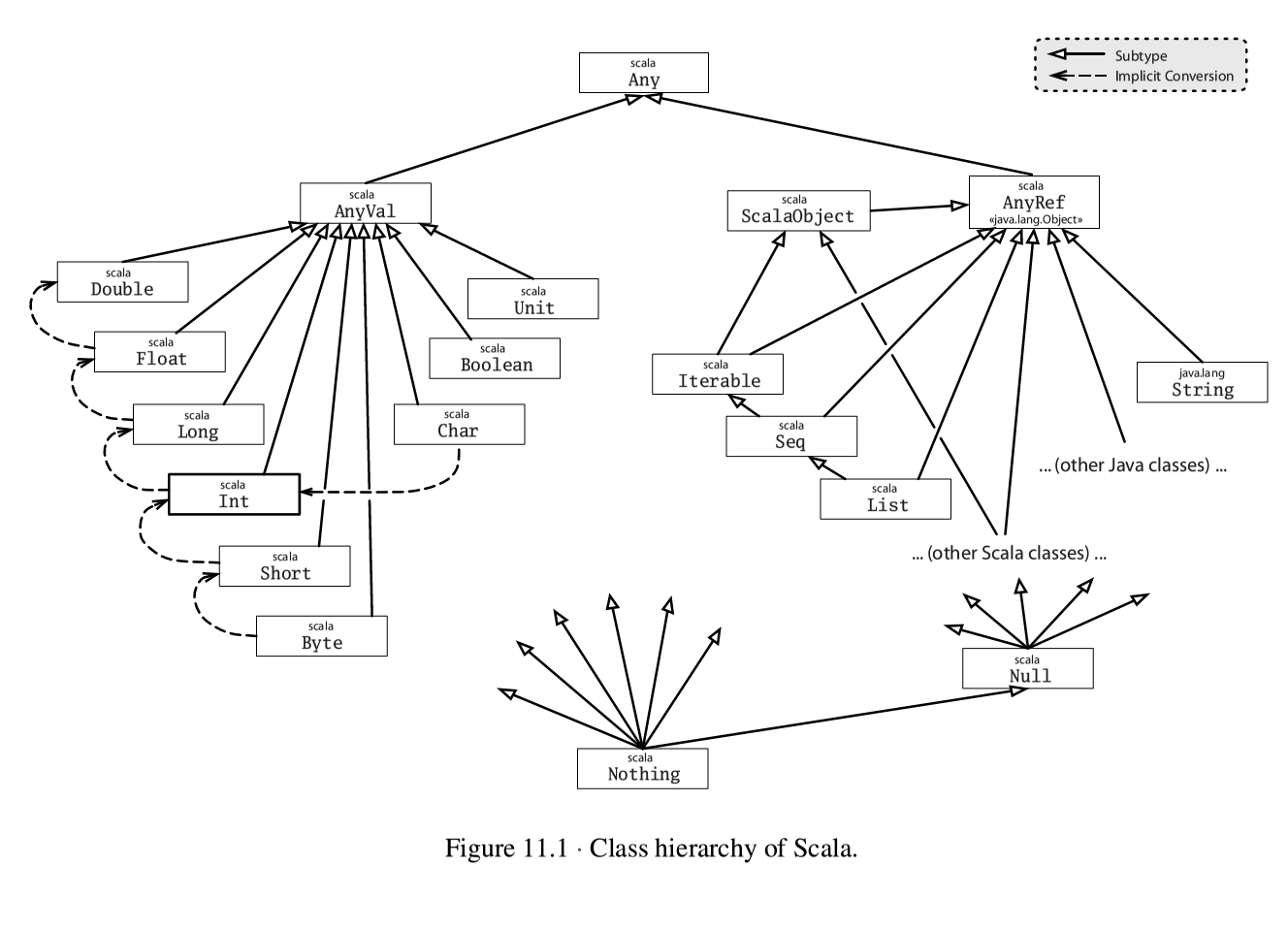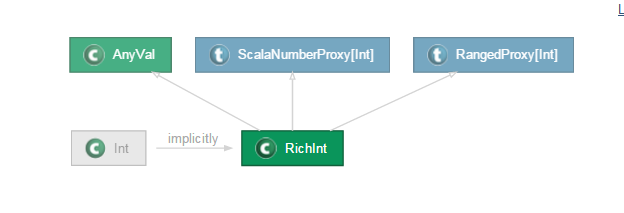本节主要内容
- 隐式转换简介
- 隐式转换函数
- 隐式转换规则
- 隐式参数
1. 隐式转换简介
在scala语言当中,隐式转换是一项强大的程序语言功能,它不仅能够简化程序设计,也能够使程序具有很强的灵活性。要想更进一步地掌握scala语言,了解其隐式转换的作用与原理是很有必要的,否则很难得以应手地处理日常开发中的问题。
在scala语言中,隐式转换是无处不在的,只不过scala语言为我们隐藏了相应的细节,例如scala中的类继承层次结构中:
它们存在固有的隐式转换,不需要人工进行干预,例如Float在必要情况下自动转换为Double类型
在前一讲的视图界定中我们也提到,视图界定可以跨越类层次结构进行,它背后的实现原理就是隐式转换,例如Int类型会视图界定中会自动转换成RichInt,而RichInt实现了Comparable接口,当然这里面的隐式转换也是scala语言为我们设计好的
本节将对隐式转换中的隐式转换函数、隐式转换规则、隐式参数进行介绍,使大家明白如何自己实现隐式转换操作。
2. 隐式转换函数
下列赋值如果没有隐式转换的话会报错:
scala> val x:Int=3.5
<console>:7: error: type mismatch;
found : Double(3.5)
required: Int
val x:Int=3.5
^添加隐式转换函数后可以实现Double类型到Int类型的赋值
//定义了一个隐式函数double2Int,将输入的参数
//从Double类型转换到Int类型
scala> implicit def double2Int(x:Double)=x.toInt
warning: there were 1 feature warning(s); re-run with -feature for details
double2Int: (x: Double)Int
//定义完隐式转换后,便可以直接将Double类型赋值给Int类型
scala> val x:Int=3.5
x: Int = 3隐式函数的名称对结构没有影响,即implicit def double2Int(x:Double)=x.toInt函数可以是任何名字,只不能采用source2Target这种方式函数的意思比较明确,阅读代码的人可以见名知义,增加代码的可读性。
隐式转换功能十分强大,可以快速地扩展现有类库的功能,例如下面的代码:
package cn.scala.xtwy
import java.io.File
import scala.io.Source
//RichFile类中定义了Read方法
class RichFile(val file:File){
def read=Source.fromFile(file).getLines().mkString
}
object ImplicitFunction extends App{
implicit def double2Int(x:Double)=x.toInt
var x:Int=3.5
//隐式函数将java.io.File隐式转换为RichFile类
implicit def file2RichFile(file:File)=new RichFile(file)
val f=new File("file.log").read
println(f)
}3. 隐式转换规则
隐式转换可以定义在目标文件当中,例如
implicit def double2Int(x:Double)=x.toInt
var x:Int=3.5隐式转换函数与目标代码在同一个文件当中,也可以将隐式转换集中放置在某个包中,在使用进直接将该包引入即可,例如:
package cn.scala.xtwy
import java.io.File
import scala.io.Source
//在cn.scala.xtwy包中定义了子包implicitConversion
//然后在object ImplicitConversion中定义所有的引式转换方法
package implicitConversion{
object ImplicitConversion{
implicit def double2Int(x:Double)=x.toInt
implicit def file2RichFile(file:File)=new RichFile(file)
}
}
class RichFile(val file:File){
def read=Source.fromFile(file).getLines().mkString
}
object ImplicitFunction extends App{
//在使用时引入所有的隐式方法
import cn.scala.xtwy.implicitConversion.ImplicitConversion._
var x:Int=3.5
val f=new File("file.log").read
println(f)
}这种方式在scala语言中比较常见,在前面我们也提到,scala会默认帮我们引用Predef对象中所有的方法,Predef中定义了很多隐式转换函数,下面是Predef的部分隐式转换源码:
scala> :implicits -v
/* 78 implicit members imported from scala.Predef */
/* 48 inherited from scala.Predef */
implicit def any2ArrowAssoc[A](x: A): ArrowAssoc[A]
implicit def any2Ensuring[A](x: A): Ensuring[A]
implicit def any2stringadd(x: Any): runtime.StringAdd
implicit def any2stringfmt(x: Any): runtime.StringFormat
implicit def boolean2BooleanConflict(x: Boolean): Object
implicit def byte2ByteConflict(x: Byte): Object
implicit def char2CharacterConflict(x: Char): Object
implicit def double2DoubleConflict(x: Double): Object
implicit def float2FloatConflict(x: Float): Object
implicit def int2IntegerConflict(x: Int): Object
implicit def long2LongConflict(x: Long): Object
implicit def short2ShortConflict(x: Short): Object
//....................
那什么时候会发生隐式转换呢?主要有以下几种情况:
1 当方法中参数的类型与实际类型不一致时,例如
def f(x:Int)=x
//方法中输入的参数类型与实际类型不一致,此时会发生隐式转换
//double类型会转换为Int类型,再进行方法的执行
f(3.14)2 当调用类中不存在的方法或成员时,会自动将对象进行隐式转换,例如:
package cn.scala.xtwy
import java.io.File
import scala.io.Source
//RichFile类中定义了Read方法
class RichFile(val file:File){
def read=Source.fromFile(file).getLines().mkString
}
object ImplicitFunction extends App{
implicit def double2Int(x:Double)=x.toInt
var x:Int=3.5
//隐式函数将java.io.File隐式转换为RichFile类
implicit def file2RichFile(file:File)=new RichFile(file)
//File类的对象并不存在read方法,此时便会发生隐式转换
//将File类转换成RichFile
val f=new File("file.log").read
println(f)
}前面我们讲了什么情况下会发生隐式转换,下面我们讲一下什么时候不会发生隐式转换:
1 编译器可以不在隐式转换的编译通过,则不进行隐式转换,例如
//这里定义了隐式转换函数
scala> implicit def double2Int(x:Double)=x.toInt
warning: there were 1 feature warning(s); re-run with -feature for details
double2Int: (x: Double)Int
//下面几条语句,不需要自己定义隐式转换编译就可以通过
//因此它不会发生前面定义的隐式转换
scala> 3.0*2
res0: Double = 6.0
scala> 2*3.0
res1: Double = 6.0
scala> 2*3.7
res2: Double = 7.4
2 如果转换存在二义性,则不会发生隐式转换,例如
package implicitConversion{
object ImplicitConversion{
implicit def double2Int(x:Double)=x.toInt
//这里定义了一个隐式转换
implicit def file2RichFile(file:File)=new RichFile(file)
//这里又定义了一个隐式转换,目的与前面那个相同
implicit def file2RichFile2(file:File)=new RichFile(file)
}
}
class RichFile(val file:File){
def read=Source.fromFile(file).getLines().mkString
}
object ImplicitFunction extends App{
import cn.scala.xtwy.implicitConversion.ImplicitConversion._
var x:Int=3.5
//下面这条语句在编译时会出错,提示信息如下:
//type mismatch; found : java.io.File required:
// ?{def read: ?} Note that implicit conversions
//are not applicable because they are ambiguous:
//both method file2RichFile in object
//ImplicitConversion of type (file:
//java.io.File)cn.scala.xtwy.RichFile and method
//file2RichFile2 in object ImplicitConversion of
//type (file: java.io.File)cn.scala.xtwy.RichFile
//are possible conversion functions from java.io.File to ?{def read: ?}
value read is not a member of java.io.File
val f=new File("file.log").read
println(f)
}编译提示隐式转换存在二义性(ambiguous)
3 隐式转换不会嵌套进行,例如
package cn.scala.xtwy
import java.io.File
import scala.io.Source
package implicitConversion{
object ImplicitConversion{
implicit def double2Int(x:Double)=x.toInt
implicit def file2RichFile(file:File)=new RichFile(file)
//implicit def file2RichFile2(file:File)=new RichFile(file)
implicit def richFile2RichFileAnother(file:RichFile)=new RichFileAnother(file)
}
}
class RichFile(val file:File){
def read=Source.fromFile(file).getLines().mkString
}
//RichFileAnother类,里面定义了read2方法
class RichFileAnother(val file:RichFile){
def read2=file.read
}
object ImplicitFunction extends App{
import cn.scala.xtwy.implicitConversion.ImplicitConversion._
var x:Int=3.5
//隐式转换不会多次进行,下面的语句会报错
//不能期望会发生File到RichFile,然后RifchFile到
//RichFileAnthoer的转换
val f=new File("file.log").read2
println(f)
}理解了这些规则之后,在使用隐式转换时才能够得心应手
4. 隐式参数
在一般的函数据定义过程中,需要明确传入函数的参数,代码如下:
package cn.scala.xtwy
class Student(var name:String){
//将Student类的信息格式化打印
def formatStudent(outputFormat:OutputFormat)={
outputFormat.first+" "+this.name+" "+outputFormat.second
}
}
class OutputFormat(var first:String,val second:String)
object ImplicitParameter {
def main(args: Array[String]): Unit = {
val outputFormat=new OutputFormat("<<",">>")
println(new Student("john").formatStudent(outputFormat))
}
}
//执行结果
//<< john >>如果给函数定义隐式参数的话,则在使用时可以不带参数,代码如下:
package cn.scala.xtwy
class Student(var name:String){
//利用柯里化函数的定义方式,将函数的参数利用
//implicit关键字标识
//这样的话,在使用的时候可以不给出implicit对应的参数
def formatStudent()(implicit outputFormat:OutputFormat)={
outputFormat.first+" "+this.name+" "+outputFormat.second
}
}
class OutputFormat(var first:String,val second:String)
object ImplicitParameter {
def main(args: Array[String]): Unit = {
//程序中定义的变量outputFormat被称隐式值
implicit val outputFormat=new OutputFormat("<<",">>")
//在.formatStudent()方法时,编译器会查找类型
//为OutputFormat的隐式值,本程序中定义的隐式值
//为outputFormat
println(new Student("john").formatStudent())
}
}添加公众微信号,可以了解更多最新Spark、Scala相关技术资讯


























 1123
1123

 被折叠的 条评论
为什么被折叠?
被折叠的 条评论
为什么被折叠?








